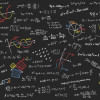At the intersection of Economics and Mathematics

As an A level Economics students, we often indulge ourselves in the realm of Keynesian theories – from the General Theory of Employment, Interest and Money to concepts such as multiplier effects and liquidity preference. John Maynard Keynes has shaped our lens of economic thinking, considering the fact that the field of macroeconomics simply did not exist before him. Yet, here is a surprising detail: Keynes himself was not formally trained as an economist. At Cambridge, he studied Mathematics, and it was Alfred Marshall, one of the leading economists of his era, who implored him to devote his mathematical faculties to Economics.
In fact, the realm of Mathematics and Economics is intertwined. Let's consider Game Theory for a second. John Nash, an American mathematician studying Governing Dynamics at Princeton University, challenged Adam Smith's principle of the "invisible hand". In a moment of eureka, he exclaimed, "Adam Smith needs revision."
Nash's work proved that, in reality, individual ambition does not inherently serve the common good, and that it is cooperation between individuals that benefits both themselves and the group — also known as the Nash Equilibrium. This moment of discovery has been wonderfully portrayed in the award-winning film A Beautiful Mind, which dramatises his journey.
These narratives indeed revolve around the same notion: for centuries, Mathematics has been the cornerstone of some of the most pivotal developments in economic thought. This is exactly where econometrics enters the scene. Econometrics is a subject that blends Mathematics, Statistics, and Economics to transform abstract theories into measurable and testable insights. It allows economists to perceive a world of complex data with clarity and evidence.
Students who study A level Further Mathematics spend time tackling foundational statistical concepts such as continuous random variables, inference using normal and t-distributions, chi-squared test, and nonparametric tests. While these topics often look highly technical on paper, econometrics paves the way for students to reflect upon using these tools from a more practical approach.
For instance, we can make inferences using normal and t-distributions. Let's assume an economist wants to know whether or not education truly raises average income. Using a sample of data, they can build a regression model and apply t-tests to check whether a positive correlation between education and income is statistically significant or just a stroke of luck. Likewise, normal distributions are also often used to model random shocks in the economy, such as fluctuations in the stock market or demand for a product. In both scenarios, Mathematics now serves a greater purpose. It's no longer constrained to a theoretical exercise, but also allows economists to draw empirical conclusions.
Worried that a career in Econometrics won't put food on the table? Rest assured, it will — and probably pay for dessert as well. This is essentially because econometricians often land roles in Quant Finance, Risk Analysis, or as Data Scientists in either the finance or tech industry. It all boils down to what you're aiming for.
The author is an A level student at Scholastica.

 For all latest news, follow The Daily Star's Google News channel.
For all latest news, follow The Daily Star's Google News channel. 








Comments